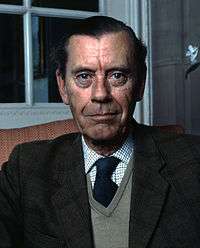John Egerton, 6th Duke of Sutherland
John Sutherland Egerton, 6th Duke of Sutherland, TD, DL (10 May 1915 – 21 September 2000) was a British peer from the Egerton family. He was styled Viscount Brackley until 1944 when he became the 5th Earl of Ellesmere /ɛlzmɪər/ on inheriting his father's substantive title and inherited his ducal title in 1963 from a distant cousin.

.svg.png)
Background and education
The son of John Egerton, 4th Earl of Ellesmere and Lady Violet Lambton, he was educated at Eton and Trinity College, Cambridge. He travelled to France with the British Expeditionary Force and was captured at St Valery in 1940. He spent four years in a prisoner of war camp. Upon his return in 1944, he succeeded his father as Earl of Ellesmere.
Career
In 1963, George Sutherland-Leveson-Gower, 5th Duke of Sutherland, his distant cousin 'Geordie', died, leaving no immediate male heir. Egerton succeeded to the dukedom, but did not inherit the Sutherland estates or Dunrobin Castle, which went to Elizabeth Janson, Geordie's niece, who became the Countess of Sutherland.
Estate duty forced the Duke to sell many pieces from the family's renowned collection of paintings and drawings. The family's wealth had shifted from landholdings to an estimated £120m collection of paintings which included Raphaels, Titians, Tintorettos, Poussins, and a large part of the famous Orléans collection from the Palais Royal in Paris. The wealth had come from the acquisitions of the third Duke of Bridgewater, who built the famous canal and passed on his mining riches, and from intermarriage. Benjamin Disraeli once paid tribute to the family's "talent for absorbing heiresses".
Despite the hundreds of paintings the Duke was forced to sell, he retained the Dutch masters for Mertoun. The Scottish National Gallery in Edinburgh had a number of notable paintings in its possession on long-term loan from the Duke of Sutherland's estate, including pieces by Titian, El Greco, Raphael and van Dyck (one of which, the Venus Anadyomene, was bought by the gallery after his death towards inheritance tax). The Duke made it clear, by selling Bridgewater House in London, that he was abandoning metropolitan pursuits. He maintained the family horse racing tradition.
A Conservative, he took his seat in the Lords in 1945, but eschewed his right to vote or speak for more than half a century.[1] He did find his political voice as a Berwickshire county councillor.
The sixth duke kept a very local profile. In 1984 he sold four masterpieces to fund improving his 20-acre (0.081 km2) garden for opening to the public. In 1994 he disagreed when the National Gallery of Scotland sought to rehouse some of his paintings in a new gallery in Glasgow, preferring them to be dispersed around Scotland.
Family
Sutherland married Lady Diana Percy (23 November 1917 – 16 June 1978), daughter of Alan Percy, 8th Duke of Northumberland, on 29 April 1939. Following the death of his first wife, on 16 August 1979 he married Evelyn Moubray, a former interior decorator who shared his love of fishing. There were no children from either marriage.
References
Citations
- HL Deb (6 December 1945) vol. 138. col. 401. Retrieved 7 January 2020.
Sources
- Roth, Andrew (5 October 2000). "Obituary: The Duke of Sutherland". The Guardian. Retrieved 7 January 2020.
- "Parliamentary career for Duke of Sutherland". UK Parliament. Retrieved 7 January 2020.
| Peerage of the United Kingdom | ||
|---|---|---|
| Preceded by George Sutherland-Leveson-Gower |
Duke of Sutherland 1963–2000 |
Succeeded by Francis Egerton |
| Preceded by John Egerton |
Earl of Ellesmere 1944–2000 | |